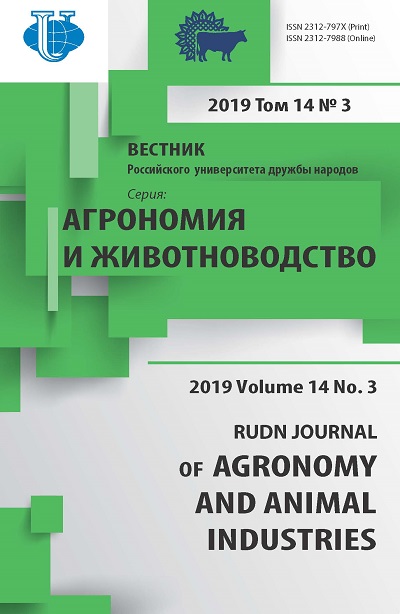Physical and chemical analysis and biochemical composition of amaranth introduced in Dagestan
- Authors: Magomedmirzoeva R.G.1, Gins M.S.2, Dadashev M.N.3
-
Affiliations:
- Federal Agrarian Scientific Center of the Republic of Dagestan
- Federal Research Vegetable Center
- Gubkina Russian State University of Oil and Gas (NRU)
- Issue: Vol 14, No 3 (2019)
- Pages: 185-195
- Section: Botany
- URL: https://agrojournal.rudn.ru/agronomy/article/view/19506
- DOI: https://doi.org/10.22363/2312-797X-2019-14-3-185-195
- ID: 19506
Cite item
Full Text
Abstract
Amaranth leaves are of high nutritional value, containing various metabolites, monoand disaccharides, photosynthetic pigments, unsaturated acids, phenolcarboxylic acids with high antioxidant activity. Vegetable amaranth is grown in different soil and climatic conditions all over the world. The article describes the results of physicochemical analysis of composition of amaranth plant introduced in southern Dagestan. The results of determining biochemical composition of vitamins, organic acids, antioxidants, betacyanin - amaranthin, chlorophyll, carotenoids and chlorogenic acid in the leaves of the introduced amaranth are presented. It has been shown that amaranth culture can be an important source of vitamins and valuable biologically active substances for both humans and animals. Based on the results obtained on amaranth introduction, it can be noted that cultivation of amaranth has great prospects in Southern Dagestan, as a mass crop.
About the authors
Ramida Gusenovna Magomedmirzoeva
Federal Agrarian Scientific Center of the Republic of Dagestan
Author for correspondence.
Email: ramida_nii@mail.ru
Senior Researcher
Makhachkala, Russian FederationMurat Sabirovich Gins
Federal Research Vegetable Center
Email: anirr@bk.ru
Doctor of Sciences in Biology, Professor, Corresponding Member of the Russian Academy of Sciences, Head of the Laboratory of Plant Physiology and Biochemistry and Introduction
Moscow region, Russian FederationMirali Nuralievich Dadashev
Gubkina Russian State University of Oil and Gas (NRU)
Email: elderismailov@mail.ru
Doctor of Sciences in Technical Sciences, Professor, Department of Physical and Colloid Chemistry
Moscow, Russian FederationReferences
- Das S. Amaranths: the crop of great prospect. In: Amaranthus: A Promising Crop of Future. Singapore: Springer; 2016. p. 13—48. doi: 10.1007/978-981-10-1469-7_3
- Repo-Carrasco-Valencia R, Hellstrom JK, Pihlava JM, Mattila PH. Flavonoids and other phenolic compounds in Andean indigenous grains: Quinoa (Chenopodium quinoa), kaniwa (Chenopodium pallidicaule) and kiwicha (Amaranthus caudatus). Food Chemistry. 2010; 120(1):128—133. doi: 10.1016/j.foodchem.2009.09.087
- Steffensen SK, Rinnan A, Mortensen AG, Laursen B, Troiani RM, Noellemeyer EJ, et al. Variations in the polyphenol content of seeds of field grown Amaranthus genotypes. Food Chemistry. 2011; 129(1):131—138. doi: 10.1016/j.foodchem.2011.04.044
- Sultanov YMA, Magomedmirzoeva RG, Alimirzoeva ZM, Rabadanov GA. Investigation of the possibility of introducing amaranth in conditions of Southern Dagestan. In: Actual problems of development of vegetable growing and potato growing. 2017. p. 185—188. (In Russ).
- Gins MS, Gins VK, Kononkov PF, Pivovarov VF, Romanova EV, Osokin IE, Gins EM. Tekhnologiya vyrashchivaniya ovoshchnogo (listovogo) amaranta [Technology for growing vegetable (leaf) amaranth]. Moscow: RUDN Publ.; 2017. (In Russ).
- State Standard 7047–55. Vitaminy A, S, D, V1, V2, i RR. Otbor prob, metody opredeleniya vitaminov i ispytaniya kachestva [Vitamins A, C, D, B1, B2, and PP. Sampling, methods for determining vitamins and quality tests].
- Sapozhnikova EV, Dorofeeva LS. Determination of ascorbic acid content in colored plant extracts by iodometric method. Food industry. 1966; (5):29—31. (In Russ).
- Kolomiyets NE, Kalinkina GI, Sapronova NN. Standardization of stinging nettle (Urtica dioica) leaves. Farmatsiya (Pharmacy). 2011; (6):22-24. (In Russ).
- Biswas M, Dey S, Sen R. Betalains from Amaranthus tricolor L. Journal of Pharmacognosy and Phytochemistry. 2013; 1(5):87—95.
- Gengatharan A, Dykes GA, Choo WS. Betalains: natural plant pigments with potential application in functional foods. LWT Food Sci Technol. 2015; 64(2):645—649. doi: 10.1016/j.lwt.2015.06.052
- Pakhomov VP, Yashin YI, Yashin AY, Bagirova VL, Arzamastsev AP, Kukes VG, Shikh EV. Sposob opredeleniya summarnoi antioksidantnoi aktivnosti biologicheski aktivnykh veshchestv [Method for determining the total antioxidant activity of biologically active substances]. Patent RUS, no. 2238554, 2004. (In Russ).
- Gins MS, Gins VK, Kolesnikov MP, Kononkov PF, Chekmarev PA, Kagan MY. Metodika analiza fenol'nykh soedinenii v ovoshchnykh kul'turakh [Methodology for analysis of phenolic compounds in vegetable crops]. Moscow: Ministry of Agriculture of the Russian Federation Publ; 2010. (In Russ).
- Lichtenthaler HK. Chlorophylls and carotenoids pigments of photosynthetic biomembranes. Methods in enzymology. 1987; 148:350—382. doi: 10.1016/0076-6879(87)48036-1
- Trineeva ОV, Slivkin АI, Safonova ЕF. Determination of hydroxycinnamic acids, carotenoids and chlorophyll in the leaves of stinging nettle (Urtica Dioica L.). Khimiia rastitel’nogo syr’ia (Chemistry of plant raw material). 2015; (3): 105-110. DOI: https://doi.org/ 10.14258/jcprm.201503522 (In Russ).
- Vysochina GI. Amaranthus (Amaranthus L.): chemical composition and prospects of use (review). Khimija rastitel'nogo syr'ja (Chemistry of plant raw material). 2013; (2):5—14. doi: 10.14258/jcprm.1302005 (In Russ).
- Zheleznov AV, Zheleznova NB, Burmakina NV, Yudina RS. Amaranth: Scientific Basis of Introduction [Amaranth: Scientific Basis of Introduction]. Novosibirsk: Geo Publ.; 2009. (In Russ).
- Osmolovskaya NG, Kuchaeva LN, Novak VA. Role of organic acids in formation of the ionic composition of glycophyte leaves in ontogenesis. Russian Journal of Plant Physiology. 2007; 54(3):381—388. (In Russ).
- Lyubimov VY. Mekhanizm fotodykhaniya v list'yakh s4-rastenii i ego regulyatsiya [Mechanism of photorespiration in leaves of c4 plants and its regulation] [Dissertation] Pushchino; 1994. (In Russ).
- Vladimirov YA. Biological membranes primary sources and targets of free radicals. In: Istochniki i misheni svobodnykh radikalov v krovi cheloveka [Sources and targets of free radicals in human blood]. Moscow; 2017. p. 5—84. (In Russ).
- Kodentsova VM, Risnik DV. Tocopherols: biological role, criteria for vitamin supply, physiological need of the body and recommended consumption norms. Nutrition. 2018; 8(2):22—31. (In Russ).
- Slimen IB, Najar T, Abderrabba M. Chemical and antioxidant properties of betalains. J Agric Food Chem. 2017; 65(4):675—689. doi: 10.1021/acs.jafc.6b04208
Supplementary files















